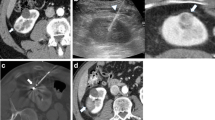Abstract
During renal cryoablation a low-attenuation area on CT develops around the cryoprobe. Knowledge of the temperature of the growing low-attenuation area can guide therapy and ensure lethal temperatures. Herein, we report thermocouple results and correlating CT images during the development of the low-attenuation “radiographic ice ball.” Five patients who underwent percutaneous CT-guided renal cryoablation were identified who had thermocouples inserted and serial intraprocedural CT images that included images with thermocouple measurements of 0° and sub-0°C. Thermocouples had been percutaneously placed just beyond the edge of the tumors either to ensure adequate cooling or to ensure safety to adjacent critical structures. Renal cryotherapy under CT guidance produced a growing low-attenuation area corresponding to the radiographic ice ball. When the thermocouple measured 0°C, CT images showed the thermocouple tip at the edge of the low-attenuation ice ball. At lower temperatures the tip was within the low-attenuation ice ball. We conclude that knowledge of the temperature at the ice ball edge during cryoablation can be used to predict the extent of tissue necrosis and thus provide an estimate of cryotherapy effectiveness during the procedure. Further work is necessary to establish a firm relationship between the thermal conditions and the zone of damage.


Similar content being viewed by others
References
Silverman SG, Tuncali K, Morrison PR (2005) MR imaging-guided percutaneous tumor ablation (1). Acad Radiol 12(9):1100–1109
Dupas B, Frampas E, Leaute F, Bertrand-Vasseur A, Lerat F (2005) [Complications of fluoroscopy-, ultrasound-, and CT-guided percutaneous interventional procedures]. J Radiol 86(5; Pt 2):586–598
Santambrogio R, Bianchi P, Pasta A, Palmisano A, Montorsi M (2002) Ultrasound-guided interventional procedures of the liver during laparoscopy: technical considerations. Surg Endosc 16(2):349–354
Hinshaw JL, Lee FT Jr (2004) Image-guided ablation of renal cell carcinoma. Magn Reson Imaging Clin N Am 12(3):429–447, vi
Popken F, Seifert JK, Engelmann R, Dutkowski P, Nassir F, Junginger T (2000) Comparison of iceball diameter and temperature distribution achieved with 3-mm accuprobe cryoprobes in porcine and human liver tissue and human colorectal liver metastases in vitro. Cryobiology 40(4):302–310
Reiser M, Drukier AK, Ultsch B, Feuerbach S (1983) The use of CT in monitoring cryosurgery. Eur J Radiol 3(2):123–128
Rewcastle JC, Sandison GA, Hahn LJ, Saliken JC, McKinnon JG, Donnelly BJ (1998) A model for the time-dependent thermal distribution within an iceball surrounding a cryoprobe. Phys Med Biol 43(12):3519–3534
Sandison GA, Loye MP, Rewcastle JC, Hahn LJ, Saliken JC, McKinnon JG, Donnelly BJ (1998) X-Ray CT monitoring of iceball growth and thermal distribution during cryosurgery. Phys Med Biol 43(11):3309–3324
Gupta A, Allaf ME, Kavoussi LR, Jarrett TW, Chan DY, Su LM, Solomon SB (2006) Computerized tomography guided percutaneous renal cryoablation with the patient under conscious sedation: initial clinical experience. J Urol 175(2):447–452, discussion 452–443
Chosy SG, Nakada SY, Lee FT Jr, Warner TF (1998) Monitoring renal cryosurgery: predictors of tissue necrosis in swine. J Urol 159(4):1370–1374
Campbell SC, Krishnamurthi V, Chow G, Hale J, Myles J, Novick AC (1998) Renal cryosurgery: experimental evaluation of treatment parameters. Urology 52(1):29–33, discussion 33–24
Goldberg SN, Grassi CJ, Cardella JF, et al. (2005) Image-guided tumor ablation: standardization of terminology and reporting criteria. Radiology 235(3):728–739
Jang TL, Wang R, Kim SC, Troe T, Pins MR, Nadler RB (2005) Histopathology of human renal tumors after laparoscopic renal cryosurgery. J Urol 173(3):720–724
Harada J, Mogami T (2004) [Minimally invasive therapy under image guidance—emphasizing MRI-guided cryotherapy]. Rinsho Byori 52(2):145–151
Gilbert JC, Rubinsky B, Wong ST, Brennan KM, Pease GR, Leung PP (1997) Temperature determination in the frozen region during cryosurgery of rabbit liver using MR image analysis. Magn Reson Imaging 15(6):657–667
Ladd AP, Rescorla FJ, Baust JG, Callahan M, Davis M, Grosfeld JL (1999) Cryosurgical effects on growing vessels. Am Surg 65(7):677–682
Author information
Authors and Affiliations
Corresponding author
Rights and permissions
About this article
Cite this article
Permpongkosol, S., Link, R.E., Kavoussi, L.R. et al. Temperature Measurements of the Low-Attenuation Radiographic Ice Ball During CT-Guided Renal Cryoablation. Cardiovasc Intervent Radiol 31, 116–121 (2008). https://doi.org/10.1007/s00270-007-9220-5
Received:
Revised:
Accepted:
Published:
Issue Date:
DOI: https://doi.org/10.1007/s00270-007-9220-5




